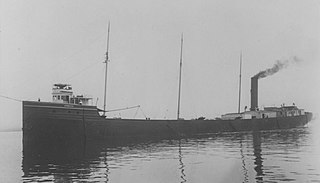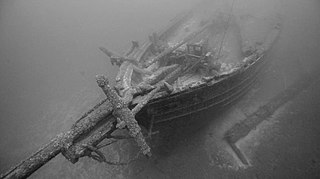The Lillie Parsons was an American two-masted schooner which sank in the Saint Lawrence Seaway near Brockville, Ontario, Canada, in 1877.

The Rouse Simmons was a three-masted schooner famous for having sunk in a violent storm on Lake Michigan in 1912. The ship was bound for Chicago with a cargo of Christmas trees when it foundered off Two Rivers, Wisconsin, killing all on board.

The SS Appomattox was a wooden-hulled, American Great Lakes freighter that ran aground on Lake Michigan, off Atwater Beach off the coast of Shorewood, Wisconsin in Milwaukee County, Wisconsin, United States in 1905. On January 20, 2005 the remnants of the Appomattox were listed on the National Register of Historic Places.

Hesper was a bulk-freighter steamship that was used to tow schooner-barges on the Great Lakes. She sank in Lake Superior off Silver Bay, Minnesota, in a late-spring snowstorm in 1905. The remains of the ship are listed on the National Register of Historic Places.

The SS Vienna was built in 1873 during the era when steamers were built with sail rigging. She had a 19 year career marked with maritime incidents including sinking when she was just 3 years old. She sank for her final time in fair weather in Whitefish Bay in Lake Superior after she received a mortal blow when she was inexplicably rammed by the steamer Nipigon. Although there were no deaths when the Vienna sank for the last time, more than 100 years later her wreck claimed the lives of 4 scuba divers, the most of all the wrecks in the Whitefish Point Underwater Preserve that now protects her as part of an underwater museum. Her wreck was stripped of artifacts that resulted in the Michigan Department of Natural Resources seizing her artifacts in a raid on the Great Lakes Shipwreck Museum in 1992. Her artifacts are now on display in this museum as loan from the State of Michigan.

The SS Samuel Mather was the first of seven U.S. merchant ships to bear that name. The wooden Mather sank in 1891 after she was rammed by the steel freighter Brazil in heavy fog in Whitefish Bay 8 miles (13 km) from Point Iroquois, ending the Mather's 4-year career. Her intact wreck is a rare of example of wooden freighters that plied the Great Lakes and she is a popular scuba diving site. Although there was no loss of life when the Mather sank, her wreck claimed the lives of three scuba divers more than 100 years after she sank. Artifacts from her wreck were illegally removed in the 1980s by the Great Lakes Shipwreck Historical Society. The artifacts are now the property of the State of Michigan and are on display as a loan to the Great Lakes Shipwreck Museum. The wreck of the Mather is protected as part of an underwater museum in the Whitefish Point Underwater Preserve.

L.R. Doty was a Great Lakes steamship launched in May 1893 at West Bay City, Michigan. It was last seen afloat October 25, 1898 north of Milwaukee, Wisconsin, during a violent storm on Lake Michigan, with winds reaching 70 miles per hour (110 km/h). The ship was witnessed foundering at the stern by a passenger of the four-masted schooner Olive Jeanette which was being towed by the Doty until the tow line broke from the force of the storm. Seventeen crew members died.

Fleetwing was a schooner that sank in Lake Michigan off Liberty Grove, Wisconsin, United States. In 2001 the shipwreck site was added to the National Register of Historic Places.

Gallinipper was a schooner that sank in Lake Michigan off the coast of Centerville, Manitowoc County, Wisconsin, United States. In 2010, the shipwreck site was added to the National Register of Historic Places.

Home was a two-masted schooner which sank in Lake Michigan off Centerville in Manitowoc County, Wisconsin, United States, in 1858. In 2010 the shipwreck site was added to the National Register of Historic Places.

The Kate Kelly was a 126-foot wood-hulled two-masted schooner that sank in 1895 off the coast of Wind Point, Wisconsin, United States. In 2007 the shipwreck site was added to the National Register of Historic Places.

The F.T. Barney was a 19th-century American schooner that sank in 1868. Her wreck in Lake Huron near Rogers City, Michigan, was listed on the National Register of Historic Places in 1991.
The General Butler was a schooner-rigged sailing canal boat that plied the waters of Lake Champlain and the Champlain Canal in the United States states of Vermont and New York. Built in 1862 and named for American Civil War General Benjamin Franklin Butler, she sank after striking the Burlington Breakwater in 1876, while carrying a load of marble. Her virtually intact wreck, discovered in 1980, is a Vermont State Historic Site and a popular dive site; it was listed on the National Register of Historic Places in 1998.

Antelope was a Great Lakes steamship that later was converted into a schooner barge) and sank in Lake Superior near the Apostle Islands in 1897.

The SS Lakeland was an early steel-hulled Great Lakes freighter that sank on December 3, 1924, into 205 feet (62 m) of water on Lake Michigan near Sturgeon Bay, Door County, Wisconsin, United States, after she sprang a leak. On July 7, 2015, the wreck of the Lakeland was added to the National Register of Historic Places.

SS Selah Chamberlain was a wooden-hulled Great Lakes freighter that sank in Lake Michigan in 1886, 6 miles (10 km) off the coast of Sheboygan, Sheboygan County, Wisconsin, United States after being rammed by the steamer John Pridgeon Jr. with the loss of five lives. On January 7, 2019, the wreck of Selah Chamberlain was listed on the National Register of Historic Places, and was given the reference number 100003288. She was the first shipwreck listed on the National Register of Historic Places in 2019.

SS Ironsides was a wooden-hulled American package freighter in service between 1864 and 1873. She was built in 1864 in Cleveland, Ohio, by either Ira Lafrinier or Quayle & Martin. She was built for John E. Turner, also of Cleveland, and operated as part of the Cleveland & Lake Superior Line. She had an identical sister ship named Lac La Belle. Ironsides operated between Cleveland and Lake Superior for a number of years, and was sold several times. In 1869, she was sold to Nathan Englemann of Milwaukee, Wisconsin, and operated between Milwaukee and Grand Haven, Michigan. In 1871, she became part of the Englemann Transportation Company.

SS Lac La Belle was a wooden-hulled American package freighter in service between 1864 and 1872. She was built in 1864 in Cleveland, Ohio, by Ira Lafrinier for Hanna & Garretson, also of Cleveland. She had an identical sister ship named Ironsides. Lac La Belle operated between Cleveland and Lake Superior for a number of years, and was sold several times. In 1869, she was sold to Nathan Englemann of Milwaukee, Wisconsin, and operated between Milwaukee and Grand Haven, Michigan. In 1871, she became part of the Englemann Transportation Company. Throughout her career, Lac La Belle was involved in several accidents.



















